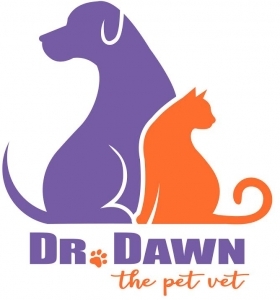 Is your dog or cat terrified of going to the veterinarian? If so, he is not alone. It can be a scary place, seen through the eyes of your pet. No one takes this fear lightly, because it makes the visit more stressful for everyone involved, including the doctor. What you should know is there is a large movement in the vet world, to make the experience “fear free” for your pet. This is not a new intention, but what is new is the large scale effort and priority many people like me are making it. From house call veterinarians, to hospital designs to make the waiting room and exam room more comfortable, to making the wait time less, many of us are making a concerted effort to create as positive an experience as possible for your pet. Pain medication and prevention has advanced, as has the near abolishment of procedures such as ear cropping, deemed inhumane by many of my colleagues.
Is your dog or cat terrified of going to the veterinarian? If so, he is not alone. It can be a scary place, seen through the eyes of your pet. No one takes this fear lightly, because it makes the visit more stressful for everyone involved, including the doctor. What you should know is there is a large movement in the vet world, to make the experience “fear free” for your pet. This is not a new intention, but what is new is the large scale effort and priority many people like me are making it. From house call veterinarians, to hospital designs to make the waiting room and exam room more comfortable, to making the wait time less, many of us are making a concerted effort to create as positive an experience as possible for your pet. Pain medication and prevention has advanced, as has the near abolishment of procedures such as ear cropping, deemed inhumane by many of my colleagues.
On our end, there are educational modules that veterinarians and technicians can participate in, and workshops to attend. The goals are, first, to be able to better recognize signs of fear, which are not always so obvious. Not every terrified dog is growling and lunging. Then there are the specific ways to minimize those feelings. Some of this information you may find interesting, and helpful in recognizing and decreasing the stress level prior to walking in the doctor’s office. And everyone benefits, because the happier you and your pet are about the visit, the more likely you will come to see us if they are sick, or for well visits, so that something caught early can be picked up and treated before it is advanced and less easily addressed.
That was then…
A large part of fear issues relates to the pain involved in some procedures, and the anticipation of it on the animal’s part. A big part of that problem is that, only relatively recently, were we taught and explained how pets feel pain. In fact, not so long ago, we were taught, incorrectly, that pets didn’t feel pain like people did. The reality is, they have the same neural pathways as us. They have emotions just like people and can feel anxiety, fear, or trust and love.
As recently as 1979, there was a debate about the existence of animal pain. The first veterinary anesthesia textbooks did not even mention pain. Yet that has changed, making the recognition of animal pain and it’s treatment instrumental in fundamentally changing veterinary practice and procedure. And it is not just pain we are talking about. This is a situation where we all need to learn to “hear” the pets. Animals have been communicating, but not everyone has been listening.
And this is now…
This and the next blog will talk about interpreting our dogs’ and cats’ communication, or body language. Then I will talk about what vets are specifically doing to change the experience for the better. When we understand where our patients are coming from, we can better serve. So let’s think like a dog or cat…
The autonomy provided by verbal speech in a language we understand cannot be underestimated. If you have ever been in another country where you did not speak the language, you may have experienced the anxiety associated with not being able to seek or understand help when you needed it. Many phrase books will tell you how to ask where a toilet is, but ironically, to understand a verbal answer, you need some facility in the language, which was the problem in the first place. If you end up getting to the toilet, it’s likely because someone pointed or kindly dragged you by the arm to a suitable location. In other words, you shared a signaling currency allowing you to indicate your goal. No technique is more underrated in veterinary medicine than using a signaling currency that allows goals to be shared and accomplished. New research shows that dogs especially can have quite large vocabularies of human words comprising nouns, verbs and modifiers, and are excellent at reading and responding to human intentional signals. The easiest of those is to study pointing, for example. On the other hand, the few studies of the reverse, show that we humans misread all but extreme canine and feline vocalizations, and we mis- or incompletely read many physical signals of stress and distress.
To add insult to injury, it seems that we veterinarians may not always be so great at communicating with the humans accompanying our patients. The median and mean lengths of time clients talk before being interrupted by their veterinarians are 11 and 15.3 seconds, respectively. Listening is a learned skill that requires patience, and helps you learn what you need to know about the patient. Good listening also does something crucial for the nonverbal partner in the exam: it provides a cadence of normal conversation, a soundtrack of calming discourse. By not having this cadence, we may have already contributed to patient distress, and fear, and all before we even put a hand on the patient. It can then progress, as in the example of patients who appear calm and complacent, who are, in reality, frozen into presumed compliance, from fear. We then proceed to manipulate them, until they struggle or become aggressive. Then, we have to restrain them, which intensifies the cycle.
For patients that don’t have it in them to fight back, this is a formula for learned helplessness Those that do fight back frequently are labeled, or mislabeled, as dangerous. Both scenarios are not good. So how can we change this? We can start by looking to human pediatric hospitals for some encouragement and ideas. Far from the bondage and discipline approach to child care that was the scary rule in the 1950s and 1960s, children’s hospitals now strive to provide some degree of autonomy to their patients. They recognize that struggle and restraint worsen stress and make sick kids sicker. If we veterinarians follow the same principles and apply a set of basic rules to visits, we can make some profound changes. This means everyone in the hospital, from the receptionist onward. To help us, you as a client should offer feedback after past appointments, and how well or not well the patient handled the visit. Some do better being the first appointment of the day, before other animals join them in the waiting room. Others love treats. Knowing your pet’s preferences and trigger points is important, both for you and for his veterinary caregivers. Share it with them. Hopefully, this knowledge will make visits more pleasant for your pet in future visits, and turn them into something they don’t dread.
Dr. Dawn
Please share and subscribe here





